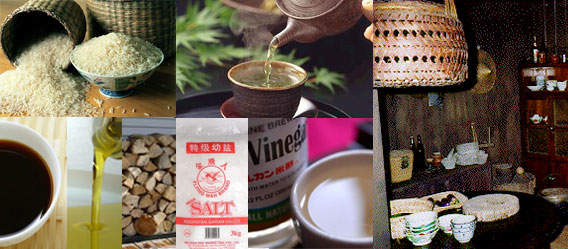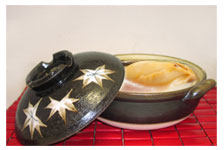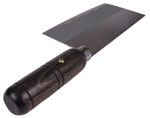| |

There is an old Chinese saying that states that there are seven must-haves in a Chinese kitchen. These seven essential must-haves are: Firewood, Rice, Oil, Salt, Soy sauce, Vinegar, and Tea. Without these seven items, a Chinese kitchen is incomplete.
Listed in that specific order, there certainly seems a certain wisdom to this saying. To a modern mind, these seven must-haves may not seem very impressive at all. However, there is a pragmatic wisdom in this saying that one must admire. Listed in the order of “firewood, rice, oil, salt, soy sauce, vinegar, and tea”, these seven must-haves are arranged from the most basic of necessities to the supplements with the function of enhancement.
In the logic of the old saying, the most basic of the seven is firewood, the very thing that makes cooking possible. Next, comes the staple-rice. Oil another basic cooking ingredient follows. Salt, soy sauce, and vinegar then follows as essential condiments in any Asian kitchen. Finally, tea supplements.
This month, in our newsletter, we will take a look at contemporary must-haves for an Asian kitchen. Using this old Chinese saying as a launching point, we will take a look at some of the must-haves for any Asian kitchen today.
Firewood
 What was literally listed in the old Chinese saying as the most basic and fundamental of the seven must-haves-firewood-today can be understood as the tools in which one uses to prepare Asian dishes and delicacies. What was literally listed in the old Chinese saying as the most basic and fundamental of the seven must-haves-firewood-today can be understood as the tools in which one uses to prepare Asian dishes and delicacies.
In order to make your favorite Asian dishes, you need to first equip your kitchen with the necessary tools. This month, we will introduce you some common cooking tools found in an Asian kitchen.
Pots, Pans and Woks
Delicious Japanese Nabe Pots
 For fans of delicious sukiyaki or shabu shabu meals, Japanese nabe pots are must haves. For those who are unfamiliar with nabe dishes. Nabe is simply the short form of the word Nabemono which refers to Japanese hot pot dishes. Commonly served in the winter, nabe dishes mostly consist of soup or stew dishes where ingredients are added to cook in a pot. In Japan and many other Asian countries today, hot pots are cooked directly on the table over a portable stove and diners can cook the food items of their choice.
Tasty Donabe Pots
Also commonly known as clay pots, donabe pots are pots made from clay or earthen ware and are very popular in Asia for cooking tasty clay pot dishes. These clay pots usually have a porous surface on the interior and are renowned for retaining flavor and moisture of food items. Rice and accompanying food items are often placed together inside the donabe pots and cooked simultaneously, the result is a surprising flavorful and tasty dish.
Chinese Woks

When it comes to stir-fry, nothing does it better than Chinese woks. Designed to enhance and ease stir-frying, Chinese woks are a must-have for lovers of stir-fry dishes. Commonly made from cast iron, nowadays one can also easily find non-stick options. With a rounded base and handles on both sides, Chinese woks are great tools and can be used for steaming, pan-frying and stewing as well.
Knives
Chinese Cleavers

Another common item found in Chinese and many Asian kitchens, Chinese cleavers features a wide rectangular blade that resembles a hatchet. It is usually used to hack through bones. The flat sides are also sometimes used to crush food items. Cleavers are also great for cutting through tough and hard vegetables.
Santoku (Multipurpose) Knives

Originating in Japan, Santoku knives, are multi-purpose knives that are a great addition to any kitchens. The name “Santoku” refers to the three cutting tasks that this knife performs well in: slicing, dicing and mincing. The design of the santoku knife’s blade and handle is engineered to work in harmony. As a result, the santoku knife is considered a well balance knife that can do a variety of cutting tasks in the kitchen.
Sushi Knives
 Sushi knives
Sushi knives are traditionally professional knives with wooden handles used by sushi chefs. These sushi knives are used to prepare sashimi-thin fresh cuts of fish and seafood for sushi-and are long knives with one-sided ground edges. If you are a fan of fresh sashimi and quality sushis, equipping your kitchen with good sushi knives would be an excellent choice.
Knife Sharpener
Having the right tools in your kitchen is not all there is to ensuring that you have the basic tools needed to prepare a good Asian meal, you still need to upkeep and maintain your tools. That is why, a knife sharper is indispensable in any Asian kitchen. If you don’t yet have one of these in your kitchen, a knife sharpener is a worthy investment. It will keep your knives in great condition and will save you time, effort and money in the long run.
Rice

Now that you have equipped your kitchen with all the basic tools, you can now move on to preparing the staple. Rice is a popular staple in many Asian countries. A commonly found staple food item in a variety of Asian cuisine from Chinese to Japanese to Korean to Thai to Indian dishes, rice also comes in a variety of types. Whether it’s Basmati rice, Japanese rice, Chinese long grain rice, Thai rice or brown rice that you love, there is one must-have you must get your hands on if you are a rice lover and that is a rice cooker.
Rice cookers
Rice cookers are easy found and widely available today. You can choose from a wide variety of rice cookers, from electric rice cookers to rice steamers. Many of today’s electric rice cooker are extremely easy to use and can produce quality rice with minimal effort with almost no skills required. Many of today’s rice cookers also comes with other functions such as keep warm, timer cooking, steam cook options. Some are so advanced, pressure cooking can also be done using rice cookers. Great for singles and for families, rice cookers can make life easy for many, and is a gift for any rice lovers.
Oil, Salt, Soy Sauce, Vinegar
 Now we get to the Asian condiments that one must-have in an Asian kitchen. Unlike in the past when diet might have been simpler, the choices offered today are endless, and the Asian spices and sauces are varied and fanciful.
You can choose from a wide range of tasty Asian sauces and condiments to add the desired flavor and effect to your Asian dishes, however, the most well-loved and popular of them all continue to be soy sauce.
Now we get to the Asian condiments that one must-have in an Asian kitchen. Unlike in the past when diet might have been simpler, the choices offered today are endless, and the Asian spices and sauces are varied and fanciful.
You can choose from a wide range of tasty Asian sauces and condiments to add the desired flavor and effect to your Asian dishes, however, the most well-loved and popular of them all continue to be soy sauce.
Produced from a fermented paste of boiled soy beans and roasted grain brine, soy sauce are known for their salty and earthy flavor.
Vinegar is another condiment that is commonly used in Chinese as well as many other Asian cuisines. Popularly used in Northern Chinese cuisine, vinegar is also used to produce sushi rice.
Whatever kind of condiments you like and would like to add to your collection, housing and storing them well is another factor to keep in mind. Other than having these condiment must-haves in your kitchen, a good condiment container and dispenser is just as important.
Tea
 As a finishing touch, having tea at the end of after a meal can be a very satisfying way to conclude a tasty meal. As with condiments, the variety of tea leaves available is wide and depending on your personal taste and preference, the choice is endless.
As a finishing touch, having tea at the end of after a meal can be a very satisfying way to conclude a tasty meal. As with condiments, the variety of tea leaves available is wide and depending on your personal taste and preference, the choice is endless.
For more information on the types of tea, please read our December 2003 newsletter. For more on the history behind tea, our July 2003 newsletter offers lots of great information.
At Mrs. Lin’s kitchen we offer a wide range of tasteful and functional tea ware and teapots that are must-haves for any tea lovers and for those looking for the finishing touch to equipping their Asian kitchens.
|
|
 |
OUR 2012 NEWSLETTERS
Must-haves in an Asian Kitchen
Hungry Ghost Festival: Remembering the Dead Through Feasting and Celebration
Decorative Ideas and Tips for Asian parties
Japanese Wedding Traditions: Shinto Style Wedding
Kodomo no hi: Japanese Children's Day
Chinese Funerals: The Chinese concept of Death and Rebirth
Hanami "The celebration of Spring"
Chinese Soups: The Way to Health and Vitality
Mrs. Lin’s Kitchen’s celebrate Hinamatsuri "Girl's Day"
Ikebana: The Spiritual Art of Living Flowers
Mrs. Lin’s Kitchen’s Guide to Celebrating the Lunar New Year
NEWSLETTER ARCHIVES
2012
2011
2010
2009
2008
2007
2006
2005
2004
2003
2002
2001
|